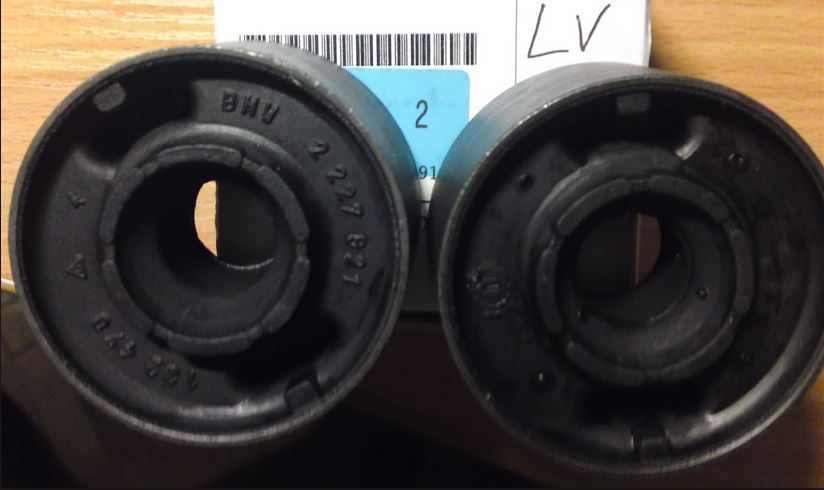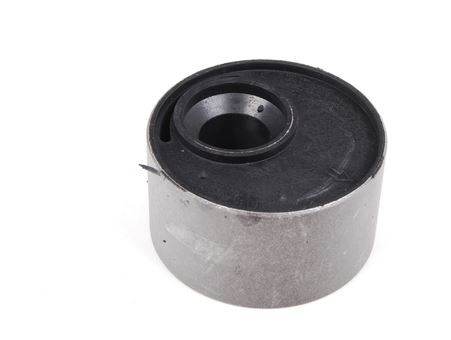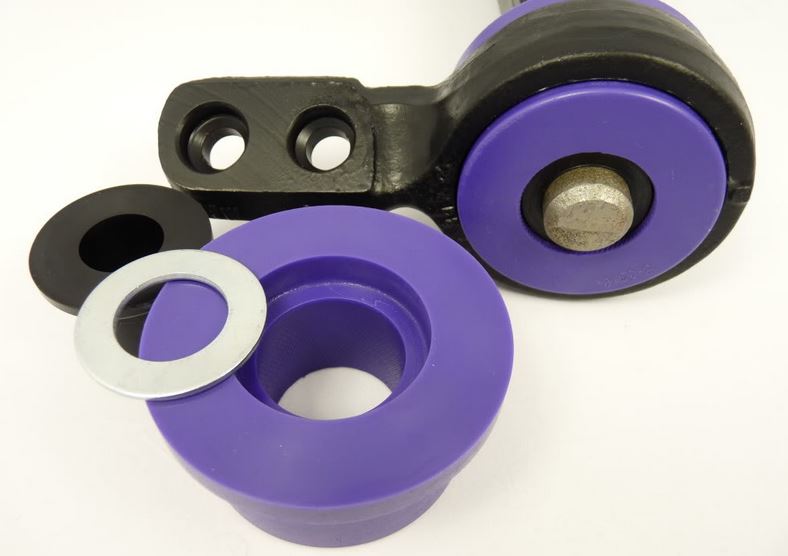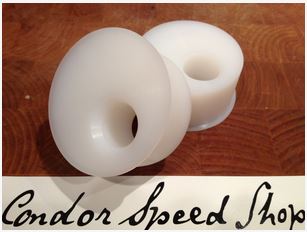Supplementary Article for specialty tools and bushing install:
https://www.rtsauto.com/control-arm-bushing-specialty-tools-and-tips/
When talking about control arm bushings, there are two ways to “upgrade” and I use that word loosely because upgrade is relative. The first way is to add rigidity to the bushing to prevent deflection under steering and braking, the second being the positioning of the bushings (centered vs offset).
The great news for E30 and E36 owners alike is that both chassis models M and non-M use the exact same bushing carrier (also known as a lollipop or wishbone bracket), allowing you to use the bushings interchangeably. Again, there is no modification required to use any of these bushings on your E30 or E36.
This is what a stock non-M E30 control bushings looks like:
This bushing is the softest of the available options and will provide for the loosest steering feel, and highest impact absorption causing for a ride that has the least amount of Noise Vibration and Harshness (NVH). With this bushing its all about comfort and the least amount of performance.
Next is the stock non-M E36 bushing:
Again this bushing is designed for comfort and reduced amount of NVH. Never the less, the bushing has more structural rigidity over the stock E30 bushing and is a marginal increase in performance with a very slight increase in NVH.
This is where we get into OEM solid rubber bushings. Essentially the M cars (E30 M3 and E36 M3) used solid rubber control arm bushings to aid in increased rigidity for increased steering precision and reduction of brake shimmy under hard braking. The E30 used an offset (eccentric) control arm bushings while the E36 used both offset and centered control arm bushing based on year (pre 1995 E36 used offset, post used centered).
An offset bushing increases the wheel caster (pushes the wheel more forward in the wheel well) which aids in high speed stability, however the down side is that it also increases steering effort and has a tendency to want to return to center. Centered bushings at lower speeds are beneficial because they allow for more precise steering and “flick-ability”, but lose out on the high speed stability. As such there is no real winner, its a matter of choice.
As a note, the reason the 1995+ M3 bushings became centered is because the control arm design was changed to provide for the increased caster instead of the bushing. So pre 1995 control arms with offset bushings will cause roughly the same caster as 1995+ control arms with centered bushings. Using an offset bushing on 1995+ control arms would cause excessive caster and is highly not recommended.
The benefit of the solid centered control arm bushing is that it allows E30 owners to realize an increase in performance with a slight increase in NVH without increasing castor and leaving the steering geometry unchanged.
Oddly enough the E30 and E36 offset bushings look identical but have different part numbers. I personally reached out to BMW Germany to learn what difference if any there was between the two part numbers. The response I received was that the two bushings differ in the rubber compound they are composed of; the E36 M3 offset bushing being stiffer.
Part number 31129064875 (as found on E36 M3)

Part number 31129061222 (as found on E30 M3)
The next category of control arm bushings we get into is aftermarket poly bushings.
Poly is an alternative for rubber and comes in a variety of hardness levels. The benefit of these type of bushings that they generally can be installed by nothing more than hand force. The downside is squeaking, loose fit (based on manufacturer), and increased NVH. The upside is that with increased rigidity you get more precise steering, and less shimmy under braking.
Powerflex provides your mid of the line poly bushings:
While places like condor offer a solid UHMW Ultra-high-molecular-weight polyethylene bushing (this should be considered a solid-solid bushing with comparable NVH to the next category).
The next category we get into is pure solid bushings. The upside of these bushings is that they will give you razor sharp steering and almost no shimmy under hard braking. The downside is that they cause significant NVH. You will feel every imperfection in the road, and any slight imperfections in the road (especially ones that have an edge) will cause thumping throughout the car. This kind of bushing is pure preference, if you can deal with the significant increase in NVH then these types of bushings are leaps ahead of the aforementioned. My personal experience is as such: I used solid control arm bushings for a year with relative comfort in one city, but when I moved to the other the NVH became unbearable due to the condition of the roads in city number 2; I have since chosen to go back to solid rubber bushings.
Generally these types of bushings are the most expensive ($150-200), however they will last almost forever, while the inner thin sleeves can be purchased for about $10.
Treehouse racing offers solid control arm bushings in both offset and centered form:
BWsport are direct competitors currently only available in offset form:
AKG caster adjustable bushings, which I would only recommend for race environments. These allow for caster adjustment but do not even have the small sleeve that the two bushings above have. This will cause extreme amounts of NVH.
For non-M E30’s my personal preference is:
1. Solid Rubber centered
2. Solid Rubber offset
3. Pure solid bushings
4. Poly bushings
5. Pure solid adjustable bushings













[…] E30 Control arm bushing upgrades (also applicable to E36) – Comprehensive guide on Control arm… on September 17, 2014 at 2:30 pm […]